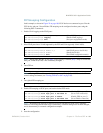
BLADEOS 6.5.2 Application Guide
BMD00220, October 2010 Chapter 14: FCoE and CEE 201
Global Configuration
PFC requires CEE to be turned on (“Turning CEE On or Off” on page 192). When CEE is turned
on, standard flow control is disabled on all ports, and PFC is enabled on all ports for 802.1p priority
value 3. While CEE is turned on, PFC cannot be disabled for priority value 3. This default is chosen
because priority value 3 is commonly used to identify FCoE traffic in a CEE environment and must
be guaranteed lossless behavior. PFC is disabled for all other priority values by default, but can be
enabled for one additional priority value.
Global PFC configuration is preferable in networks that implement end-to-end CEE devices.
For example, if all ports are involved with FCoE and can use the same SAN and LAN priority
value configuration with the same PFC settings, global configuration is easy and efficient.
Global PFC configuration can also be used in some mixed environments where traffic with
PFC-enabled priority values occurs only on ports connected to CEE devices, and not on any
ports connected to non-CEE devices. In such cases, PFC can be configured globally on specific
priority values even though not all ports make use them.
PFC is not restricted to CEE and FCoE networks. In any LAN where traffic is separated into
different priorities, PFC can be enabled on priority values for loss-sensitive traffic. If all ports
have the same priority definitions and utilize the same PFC strategy, PFC can be globally
configured.
Note – When using global PFC configuration in conjunction with the ETS feature (see “Enhanced
Transmission Selection” on page 204), ensure that only pause-tolerant traffic (such as lossless
FCoE traffic) is assigned priority values where PFC is enabled. Pausing other types of traffic can
have adverse effects on LAN applications that expect uninterrupted traffic flow and tolerate
dropping packets during congestion.


















